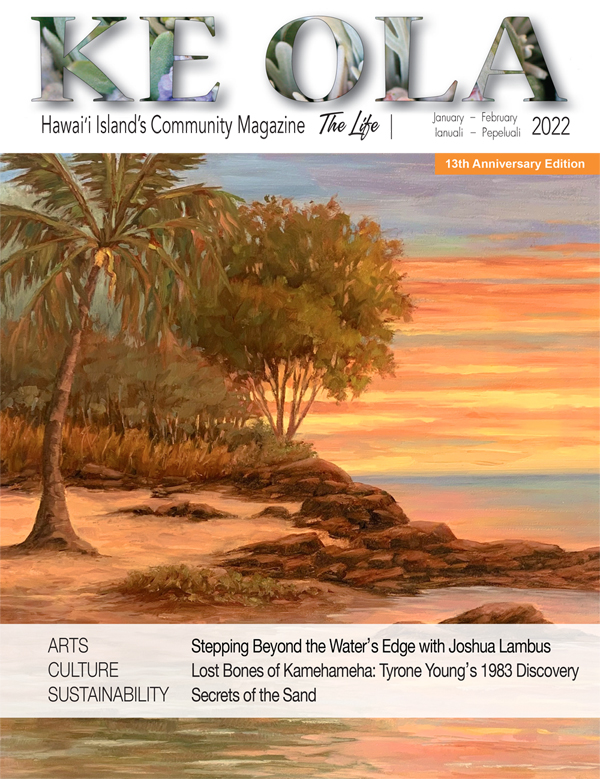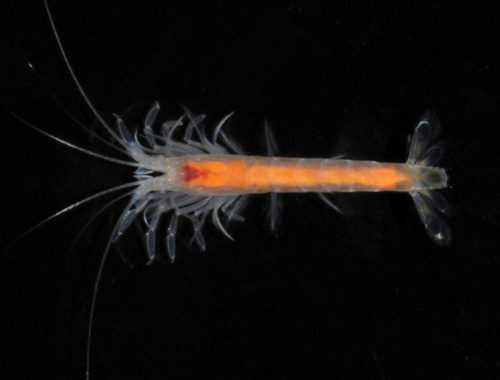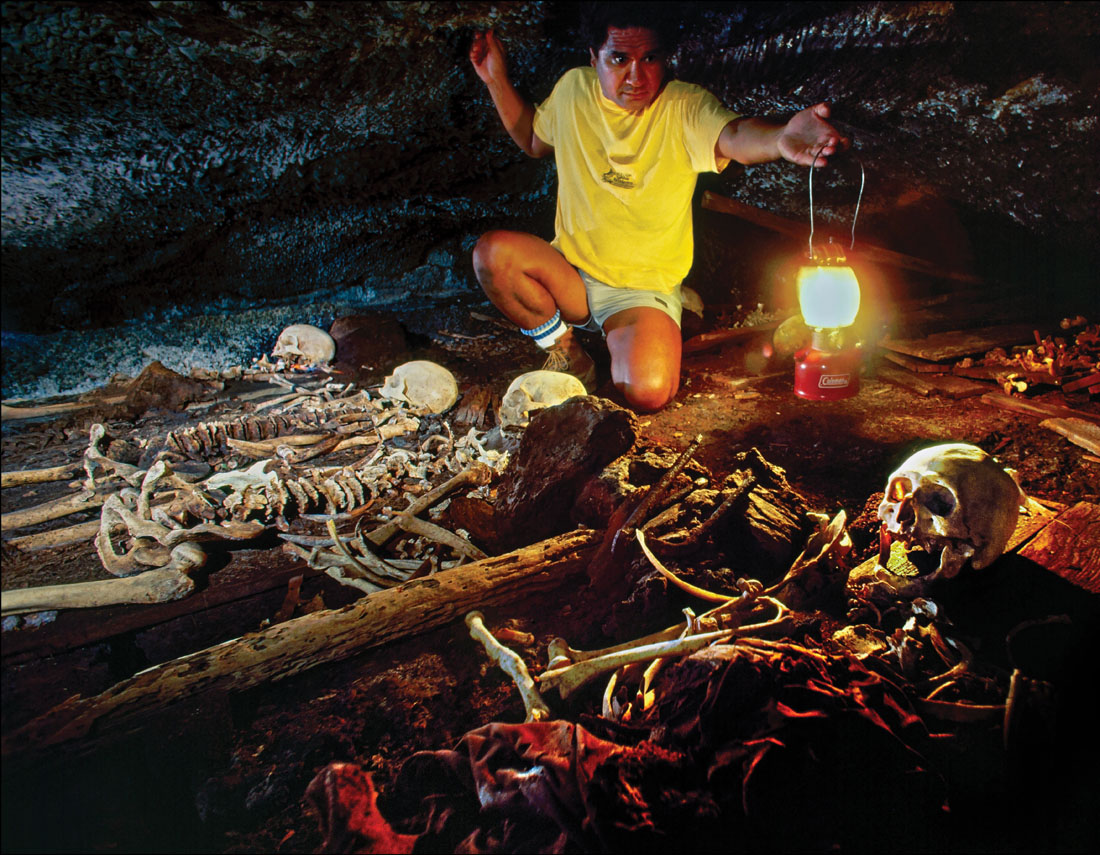
Lost Bones of Kamehameha: Tyrone Young’s 1983 Discovery

By Melisse Malone
Native Hawaiian Tyrone Young, age 82, was born in the wild isolation of Waipi‘o Valley. Now, he is coming forward to disclose details of his mana‘o (truth) about the most haunting event of his life that has remained unsettled in his heart for almost 40 years.
In 1983, Tyrone, then 44, was asked to accompany a National Geographic photographer into the burial chambers of a North Kona lava tube complex. The magazine wanted Tyrone to pose with the skeletons of the four massacred sailors from the Fair American, a schooner captured off the Kona coast in 1790.
The photograph appeared in an article titled “Kamehameha, The Warrior King,” by Louise Levathes, for the November 1983 issue. Tyrone, who was claustrophobic, reluctantly entered the lava tube. He was startled to see the extraordinary sight of a complete skeleton in a canoe. It appeared to be at least seven feet in length. To this day, Tyrone believes—without a doubt—that the bones in this canoe are the lost bones of King Kamehameha the Great, the first ruler of the Hawaiian Kingdom. The “lost” bones refer to the infamous two-century-long search to locate the king’s final resting place, somewhere along the Kona coast. Today, the location of the lava tube burial is a protected historical site on land owned by Bishop Estates.
Bone Boy of Sacred Waipi‘o
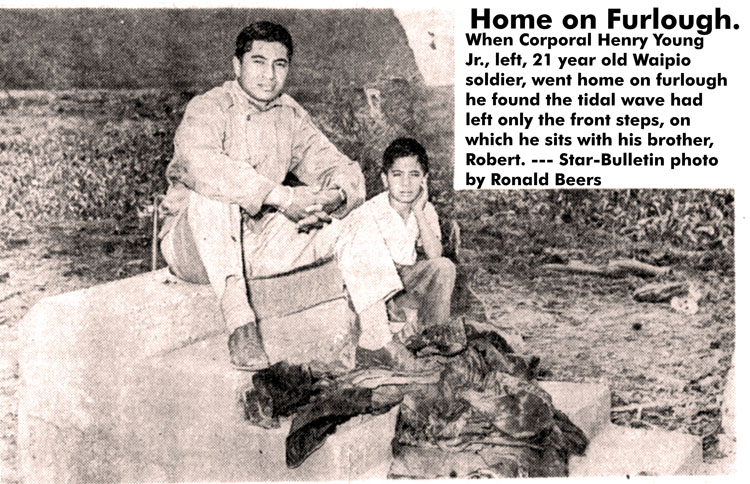
On April 1, 1946, the most destructive tsunami in Hawai‘i’s modern history hit the Hawaiian Islands. “In Waipi‘o,” explained Tyrone, “the waves destroyed my grandfather’s rice fields and dragged my grandmother inside her house a mile deep into the valley. It also tore apart the ancient sacrificial temple, Pa‘akalana Heiau [historical spelling Paka‘alana], that had stood guarding the mouth of the valley for centuries. The young conqueror Kamehameha once tended the heiau when Waipi‘o was the ancient capital of Hawai‘i Island.
“After the tsunami, when my father leased 11 acres from the Bishop Museum to farm lo‘i kalo [wetland taro] as part of the deal, they made him caretaker of the ruins of Pa‘akalana Heiau.
“During the winter months, the kona winds blew from the south over the black sand beach and exposed the bleached white bones of the fallen warriors that had been displaced under the heiau debris. My older brother Robert and I were tasked with reburying the fractured skulls, thigh bones, and pieces I could not name. I was eight years old when my father stood over me and said, ‘Never touch the bones with your bare hands. Grab a piece of driftwood to dig a hole. Get them back in the earth. Hurry son. Don’t tarry!’”
A Favor for a Friend
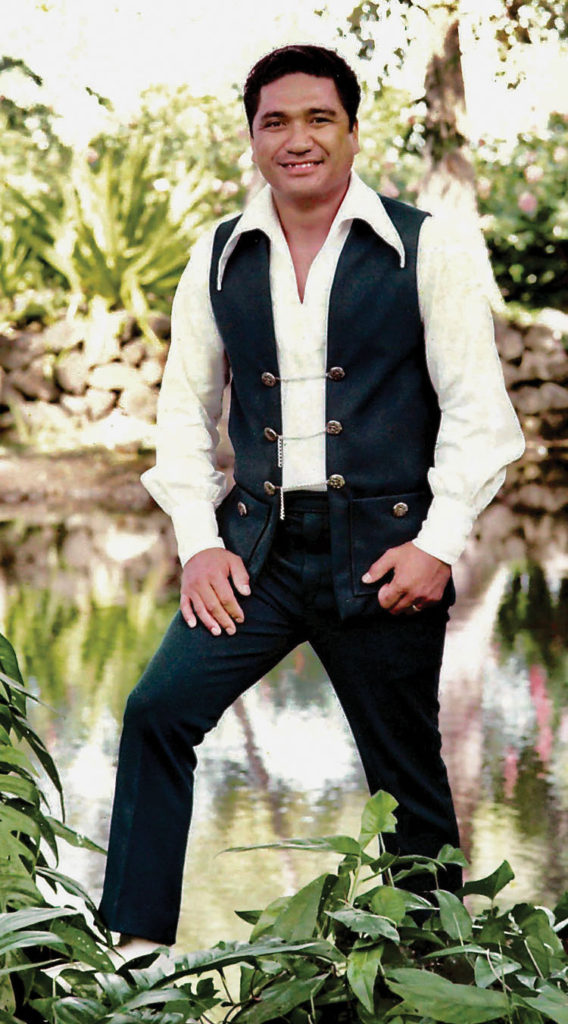
It was the 1970s. Tyrone, named after the Hollywood matinee idol Tyrone Power, was the star headline entertainer at the Polynesian Revue on the sacred grounds of the Keauhou Beach Hotel, known as “the gathering place.” He regaled audiences of 500 nightly with his soaring three-octave operatic voice, trained by his tūtū-man, Sam Lia, Jr., the famed “fiddle” troubadour of Waipi‘o Valley.
Most mornings, Tyrone had breakfast at the hotel with his good friend Herb Kawainui Kāne, renowned Hawai‘i Island artist-historian (1928–2011). They loved to share stories about Hawaiian history and reminisce. Herb’s brilliant, highly realistic paintings of events in Hawaiian history hung in the hotel lobby. Management had given him a complimentary sixth floor room/art studio to paint.
“Our friendship went way back,” said Tyrone. “Both of us had barefoot Waipi‘o childhoods, steeped in the mystical lore of the valley. Herb also knew my family’s heritage.
“My pure Hawaiian maternal grandmother and great-grandmother were born and raised in a hale pili (grass house) in neighboring Waimanu Valley. They are descendants of the Na Mahoe twins Kamanawa and Kame‘eiamoku, the lifelong guardians and advisors of Kamehameha the Great.
“One day, Herb asked me if I would go into a lava tube that contained the remains of the Fair American sailors killed by my ancestor Kame‘eiamoku. My decision was difficult because, as a Kanaka Maoli [Native Hawaiian], I was taught it was disrespectful to enter burial caves, strictly kapu [forbidden]. I agreed to go as Herb was my friend and like an older brother to me.”
A King and His Canoe
It was ten oʻclock on a clear blue August morning in 1983 when three accomplished mid-life professionals stood nervously over a three-foot-wide crack in the vast lava-blackened plains of Ka‘ūpūlehu, North Kona. On assignment, Steve Raymer, a world-class photographer, arrived at Kona airport the night before after a 20-hour flight from Bangkok. Next to him stood Herb Kāne and Tyrone Young.
“Herb was going to stay up top and keep watch. He repeated instructions to Steve and me that we would be passing through three chambers to reach the burial of the Fair American sailors. Only one photograph was allowed,” said Tyrone.
“Then Herb, who was the builder of the legendary sailing canoe Hōkūle‘a, pressed a measuring tape in my hand and told me that there was a canoe in the first chamber. He asked me to measure the length for him. I went in first by myself. I hit the bottom of a cold, dank chamber, and sure enough, there was the canoe, a single hull made of roughhewn koa.
“I was shaking in disbelief because I was not alone. Stretched out inside was a magnificent white skeleton. It was whole; every bone was placed in perfect order. From a crack in the lava tube ceiling, a ray of sunlight streamed down over the massive skull. The eye sockets glittered. I was spellbound.

“Mixed with shock and awe, I felt in my heart…this is him, this is My King; here are the lost bones of King Kamehameha the Great, the first ruler of the Hawaiian Kingdom. It all happened in an instant.
“Then I had to take measurements for Herb. The canoe was over 12 feet long. My heart was pounding when the skeleton measured almost seven feet, as I remembered my father describing King Kamehameha as nearly seven feet tall.”
“When Steve joined me, I quickly signaled for him to follow me into the middle chamber. The passageway was suffocating. I held up the lantern and saw pitch-black walls of floor-to-ceiling natural crevices that were filled with ka‘ai, woven sennit [coconut husk] caskets. I counted eight or more. They appeared intact. The traditional burial baskets were specifically made for the ‘iwi [bones] of ali‘i [royalty]. I immediately knew by their miniature size that they held the ‘iwi of infants, stillborn births, resulting from inbreeding by chiefs. As a youth in Waipi‘o Valley, I witnessed the making of ka‘ai by a kahuna [high priest].
“Finally, crouching, we reached the farthest, deepest chamber where I eyeballed the skeletons of the four victims of the Fair American massacre. Three were short, all the same length, and the fourth one much taller: American teenager Thomas Metcalfe, captain of the schooner Fair American and his three Chinese crew.”
A few days after the March 16, 1790 attack, Kamehameha arrived at the scene and angrily rebuked his trusted advisor Kame‘eiamoku for his deed. Then he ordered the remorseful Kame‘eiamoku to place the bodies of the “foreigners” deep in the lava tube where Tyrone and Steve were now sweating profusely.
The King with His Children
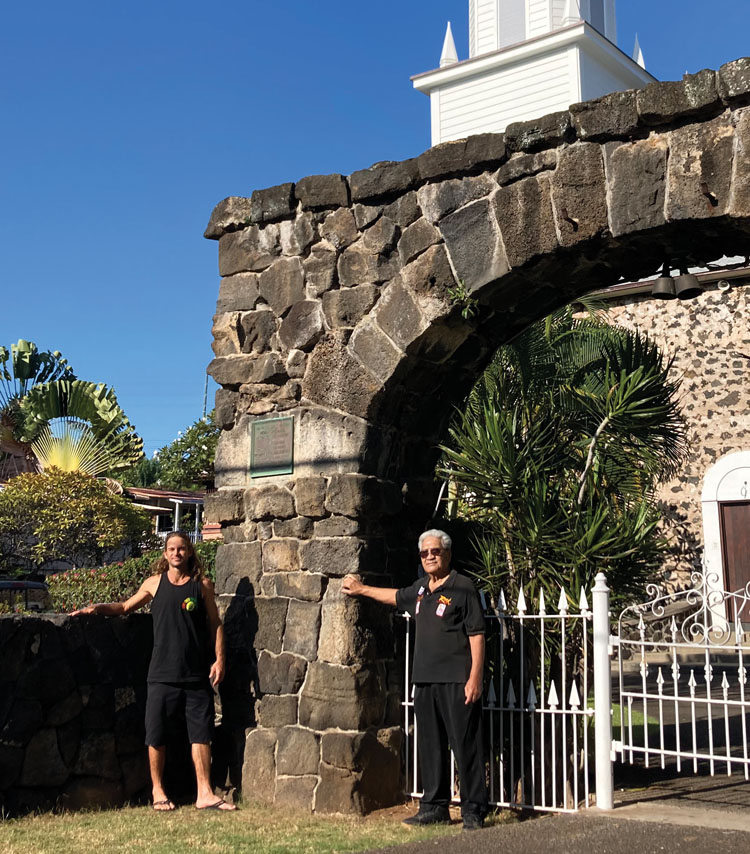
Kamehameha married his niece in 1795 when she was around 17 years old, the Sacred Queen Keōpūolani, the highest-ranked royal in the kingdom. They had 11 or 12 children together. “Divine” heirs to enlarge the Kamehameha dynasty were cherished. Of three children who survived to adulthood, two became rulers of Hawai‘i: Kamehameha II and Kamehameha III. Hawaiian historian David Malo in his 1842 account of the life of Keōpūolani, reported that eight children of the King and Queen were stillborn.
In the oral histories of the Hawaiian culture, death is not the end of life. Life continues unbroken through mana (divine power) inherent in the ‘iwi (bones) as ‘aumākua (the spirit guardians of the ohana (family). So prized for their mana, bones of the ali‘i (royalty), including infant royalty, had to be hidden away in caves with the greatest secrecy. On his death bed, on May 8, 1819, Kamehameha gave his most trusted advisor Hoapili, the son of chief Kame‘eiamoku, the highest honor of caring for his bones. At that time, Hoapili was married to Keōpūolani, and the destiny of the King lay in their hands.
Reverend Pogue’s Mo‘olelo Hawai‘i of 1858 is the first written reference to the concealment of Kamehameha’s bones in a secret burial cave: “…Hoapili ordered his man (half-brother) Ho‘olulu to take the bones of Kamehameha to Kaloko. The next morning, Hoapili and Keōpūolani sailed by canoe to Kaloko. Then Hoapili hid the bones of Kamehameha in a secret cave [lua huna] at Kaloko perhaps.” (Ka Hae Hawaii, Nov. 17, 1858). It is conceivable thieves would not suspect that Kamehameha had planned with Hoapili and Keōpūolani to have his sacred ‘iwi (bones) hidden in a canoe in a lava tube known to contain the sailors of the Fair American. Or that a loving mother like Keōpūolani had visited perhaps for years, the middle chamber, the family crypt she had chosen for her royal children with Kamehameha.
In the dark and quiet of that early morning long ago, Hoapili and Keōpūolani had a mission to complete: escorting a loving father on his final journey home to be with his children. ❖
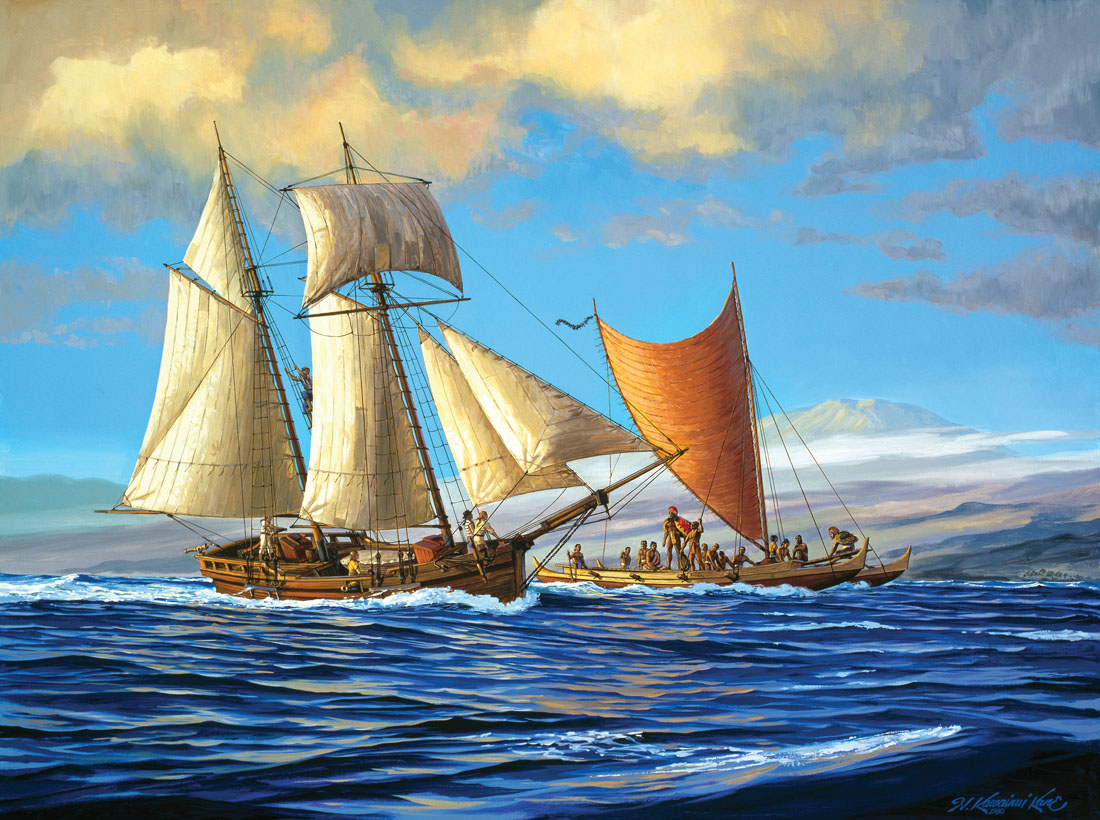
Currently, Tyrone is working on his Kailua-Kona cultural center, Hawaiki Na Na Kanaka. He would like to dedicate this story to the memory of his dear brother, Herb Kawainui Kāne, who died on March 8, 2011.
Aloha Oe!
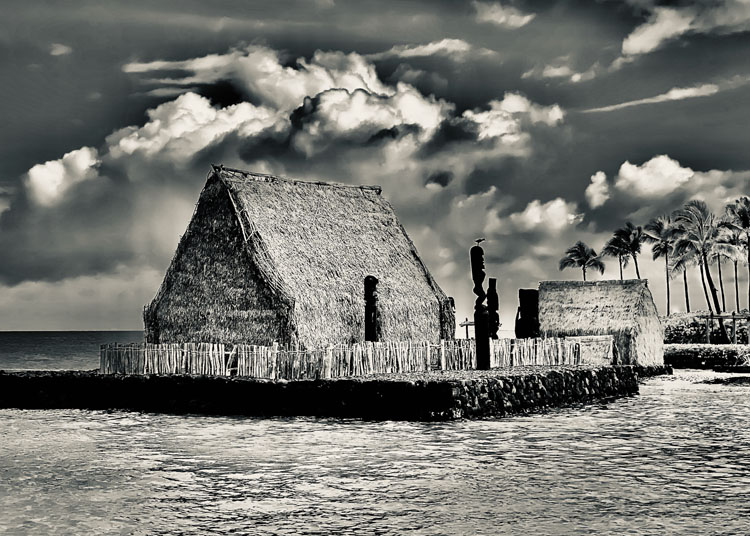
We met one August morning, 1983.
The meeting was brief, but to this descendent of the High Chiefs who served him (Na Mahoe Kamanawa and Kame‘eiamoku), it was a very spiritual encounter to see him lying in his royal canoe, sailing to the stars, where his people await his arrival!
Aloha! My Kanaka Makua! My Ali‘i!
Aue! Aue! My King, Kamehameha!
We are now united together on this star called Hawaiki. Aloha Oe!
Tyrone Young, August 2021
